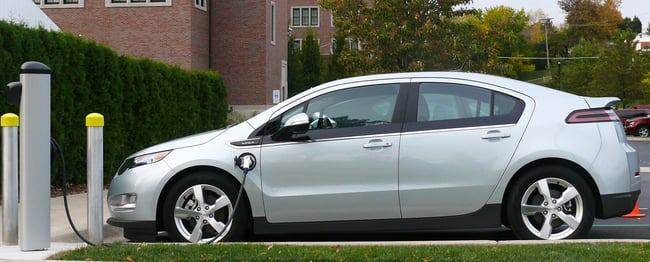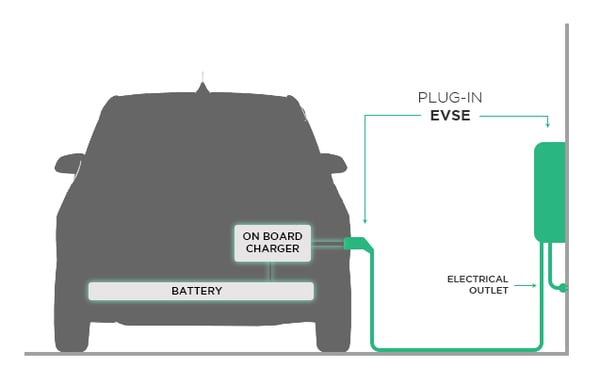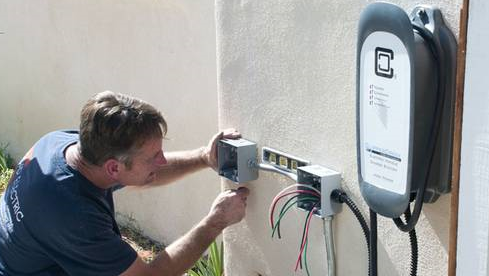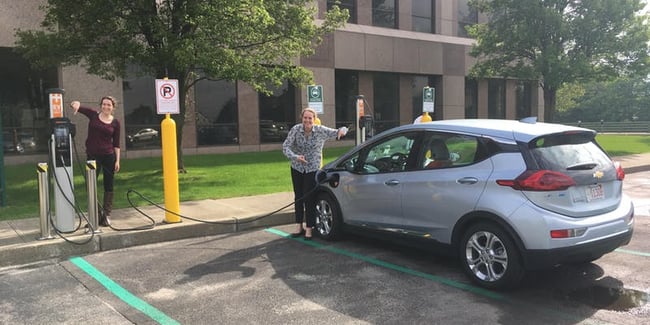There are three levels of charging available for electric cars today: Level I, Level II, and DC fast charging.
- Level I charging requires a standard 120-volt outlet. All electric vehicles come equipped with a cord that you can plug into a common outlet. It’s exactly like charging a smartphone or laptop.
- Level II charging requires a 240-volt outlet and a charging unit. You can purchase a Level II charging unit and install it in your home with the help of a licensed electrician. If you don’t already have a 240-volt outlet in your home for a washer or dryer, an electrician can set that up, too.
- DC fast charging is the fastest charging available for passenger cars. You cannot install a DC fast charging unit in your home, but they are available for public use for charging on the go.
 Most EV drivers charge at home as a matter of convenience. However, public charging makes it easier for drivers to charge on-the-go or when they need a little extra juice.
Most EV drivers charge at home as a matter of convenience. However, public charging makes it easier for drivers to charge on-the-go or when they need a little extra juice.
How long will it take to charge?
Charging is totally different from refilling gasoline. Most gas-powered cars are refueled when they are nearly empty. On the other hand, EVs are charged opportunistically; when there’s a plug available, drivers use it.
EV charging takes advantage of all the time cars spend parked, which is estimated to be 95% of the time. Even though it takes longer than pumping gas, charging is not time spent actively attending to the car – it’s time spent sleeping, eating, or working while the car is parked, so don’t be scared away by seemingly long charging times. In fact, since it takes less time to plug in at home or at work than to drive to a station and pump gas, EVs can save time that you would otherwise spend driving to and from the gas station.
The chart below shows the time it takes to go from empty to full charge of some popular EV models.
| Car |
Range |
Level I Charging Time |
Level II Charging Time |
| Chevy Bolt |
238 miles |
43 hours |
8.5 hours |
| Hyundai Kona |
258 miles |
45.5 hours |
9 hours |
| Tesla Model 3, Standard |
240 miles |
36 hours |
6.5 hours |
| Kia Niro EV |
239 miles |
60 hours |
10 hours |
| Nissan LEAF |
151 miles |
28.5 hours |
6 hours |
| Nissan LEAF Plus |
226 miles |
60 hours |
11 hours |
| Toyota Prius Prime |
25 miles |
6.5 hours |
2.5 hours |
| Honda Clarity Plug-in |
47 miles |
12 hours |
2.5 hours |
Source: ClipperCreek
There’s a lot of variability in the charging times listed above, which makes it hard to compare different cars on an apples-to-apples basis. In general, the further a car can travel on a single charge, the bigger its battery is, and the more time it takes to charge back to 100%. To get a clearer comparison, we should be looking at charging rate, or miles of range gained per hour of charging.
The chart below shows average charging rates for the same group of EVs, though ambient temperature and the battery’s state of charge will cause small fluctuations in the actual rate. (Batteries charge faster between 20% and 80% capacity than when they’re nearly full or nearly empty - another reason EV drivers tend to prefer charging more often for shorter periods of time.)
| Car |
Acceptance rate |
Level I Charging Rate |
Level II Charging Rate |
| Chevy Bolt |
7.2 kW |
4 miles/hour |
24 miles/hour |
| Hyundai Kona |
7.2 kW |
4 miles/hour |
24 miles/hour |
| Tesla Model 3, Standard |
7.7 kW |
4 miles/hour |
25 miles/hour |
| Kia Niro EV |
7.2 kW |
4 miles/hour |
24 miles/hour |
| Nissan LEAF |
6.6 kW |
4 miles/hour |
22 miles/hour |
| Nissan LEAF Plus |
6.6 kW |
4 miles/hour |
22 miles/hour |
| Toyota Prius Prime |
3.3 kW |
4 miles/hour |
11 miles/hour |
| Honda Clarity Plug-in |
6.6 kW |
4 miles/hour |
22 miles/hour
|
Source: ClipperCreek
The chart shows EVs all charge at the same rate when attached to a regular outlet, no matter the battery size. When it comes to Level II charging, there's more variation. Why is that?
What happens when you plug in
When most people say “charger,” they mean the cable that connects the power source to the device being charged, but that’s not quite accurate. An EV’s onboard charger is located inside the car and converts AC power from the wall outlet to DC power that can be stored in the battery. The speed at which an electric car can charge is limited either by the acceptance rate of the onboard charger or the power coming from the wall outlet – whichever is lower. Take a look at the diagram below to see how energy flows to the battery during charging.
 Electric Vehicle Supply Equipment (EVSE) is just a fancy term for charging station. For Level I and Level II charging, the onboard charger determines the fastest rate that a car can charge. In the diagram, it’s clear that all energy has to go through the onboard charger before it can be stored in the battery. Source
Electric Vehicle Supply Equipment (EVSE) is just a fancy term for charging station. For Level I and Level II charging, the onboard charger determines the fastest rate that a car can charge. In the diagram, it’s clear that all energy has to go through the onboard charger before it can be stored in the battery. Source
Level I charging delivers about 4 miles of electric range per hour of charging for all electric cars because the maximum power that a common outlet can deliver is 1.4 kW. All new EV models have acceptance rates that exceed 1.4 kW, but since the power that comes from the outlet is limited to 1.4 kW, the charging rate of the car is too.
There is more variability in Level II charging speeds because different EVs have different acceptance rates. The EVs with similar charging rates, such as the Chevy Bolt, Kia Niro, and Hyundai Kona, all have a 7.2 kW onboard charger and charge at a rate of about 24 miles per hour. The Tesla Model 3 has a 7.7 kW charger, so it adds an additional mile of driving range per hour of charging on Level II.
However, having an onboard charger with a higher acceptance rate adds weight and cost to the car. That’s why plug-in hybrids tend to have lower acceptance rates than battery-electric vehicles – around 3.3 kW compared to 7.2 kW.
What to look for in a charging station
Understanding how charging works is helpful for understanding your EV and for picking out a charging station that will suit your needs.
The maximum power output of a typical, 32-amp at-home charging station plugged into 240-volt outlet is 7.7 kW, which translates to a maximum rate of 25 miles of range per hour of charging. Cars like the Chevy Bolt have a 7.2 kW acceptance rate, so the actual average charging rate is a little lower - about 24 miles/hour. On the other hand, a Tesla Model S has acceptance rate of 11.5 kW, so it will charge at a rate of 25 miles per hour when plugged into the same charging station, but can accommodate a faster rate with a more powerful station.

Installing a charging station in your home can cost around $1,000, including the electrician's time.
There are EV charging stations that can deliver more or less power from the same 240-volt outlet because they draw more or less current; charging stations can deliver 12 to 80 amps, so charging rates for Level II chargers can vary between 3.8 kW and 15.4 kW.
When shopping for an at-home Level II charging station, its power output should roughly match the EV’s acceptance rate. More powerful stations are more expensive. Here are a few factors to consider when comparison shopping for your EVSE.
- Current - 30 and 32 amp chargers are most common since they deliver 7.2 and 7.7 kW of power, respectively. Many EVs on the market today have acceptance rates of about 7.2 kW, but check your car’s specs before buying a charging station; shelling out more money for a high-current station won’t necessarily make your car charge faster.
- Cord length – The cord should easily reach your plug port from the station. Going with a longer cord offers you a little more flexibility; 25 feet is recommended for most people, but measure to make sure that’s enough. You cannot use an extension cord to give yourself extra length!
- Physical size – Some charging stations are bulkier than others. Consider the space you have to install the station and the dimensions of the unit.
- Smart features – If you’d like to monitor your charging, schedule charging sessions for off-peak times from your phone, or know exactly how much energy you’re using, you can opt for a smart charger with Wi-Fi connectivity.
For more advice, check out this buyer’s guide for home chargers.
Can we charge any faster?
When it comes to overnight charging, Level I and II can deliver full driving range in the 6-8 hour window that most people are sleeping or working. Onboard chargers will likely stay as small as possible to optimize for other important factors like range and cost, but as batteries get more energy dense and lighter, faster charging could be on the way, too.

Although cars like the Chevy Bolt can only charge at a max rate of 7.2 kW using Level II charging, DC Fast Charging can add 90 miles in 30 minutes of charging, which translates to a rate of 50 kW.
And to some extent, faster charging is already here. DC fast charging stations are available for public use and can deliver as much as 50 kW of power to cars like the Bolt or as much as 150 kW for the new LEAF – much faster than their onboard chargers can accommodate. How is that possible? The third and final part of this series will focus on DC fast charging – what it is, how much better it can get, and how EVs can whittle hours of charging down to the time it takes to make a quick pit stop.
 A generous donor will match up to $10k through September 30th. With your help, we could raise $20,000 for climate and clean energy!
A generous donor will match up to $10k through September 30th. With your help, we could raise $20,000 for climate and clean energy!
.png?width=650&name=big-EV%20Charging%20101%20(3).png)
 Most EV drivers charge at home as a matter of convenience. However, public charging makes it easier for drivers to charge on-the-go or when they need a little extra juice.
Most EV drivers charge at home as a matter of convenience. However, public charging makes it easier for drivers to charge on-the-go or when they need a little extra juice. Electric Vehicle Supply Equipment (EVSE) is just a fancy term for charging station. For Level I and Level II charging, the onboard charger determines the fastest rate that a car can charge. In the diagram, it’s clear that all energy has to go through the onboard charger before it can be stored in the battery.
Electric Vehicle Supply Equipment (EVSE) is just a fancy term for charging station. For Level I and Level II charging, the onboard charger determines the fastest rate that a car can charge. In the diagram, it’s clear that all energy has to go through the onboard charger before it can be stored in the battery. 


Comments